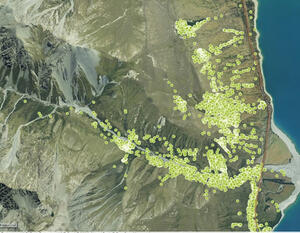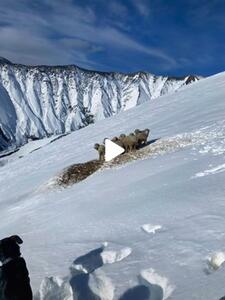A lot has happened since our last update.
As most of you will be aware, the Crown Pastoral Land Reform Act received Royal assent on the 17 May.
This is a major milestone, which not only ends tenure review but changes the way we administer this iconic land.

Sonya Wikitera - Head of Crown Property
Over the last couple of years, we’ve taken a more active approach and increased pastoral lease visits, and we look forward to building on this as we enter this next phase.
We are now consulting on proposed new regulations and standards to support the implementation of other changes in the Act that will come into effect in November. Consultation closes on Friday 19 August.
In this issue, we have more information about the regulations and standards, as well as everything you need to know to make a submission, and upcoming information sessions.
The team is updating our Guide for Pastoral Leaseholders to reflect the changes and we will be looking for your ongoing feedback on this.
While tenure review ended the day after the Act received Royal assent, those reviews where a substantive proposal has been put to or accepted by a leaseholder will continue. We have an update on those that are continuing in this issue.
Aside from all things related to the Act, including changes to our consent regime, we have an update on our pastoral lease visits, a profile on our pastoral team member Brad Baxter, and more.
I hope you enjoy our latest issue.
Heoi anō tāku mō nāianei,
Sonya Wikitera – Head of Crown Property
Consultation open on proposed regulations and standards
We are seeking feedback on the proposed new regulations and standards to support the implementation of the Crown Pastoral Land Reform Act last month.
The new regulations include detailing the information required for consent applications, matters the Commissioner of Crown Lands (Commissioner) must consider in deciding the level of adverse effects of a pastoral activity on inherent values, and infringements.
Two new standards have also been proposed.
This includes a standard for the Commissioner when accessing applications for easements, transfers and subleases of pastoral land.
Also, a Chief Executive standard that relates to how the Commissioner determines applications for discretionary pastoral activities, commercial recreation permits and stock exemptions.
To find out more about the proposed regulations and standards, or to make a submission, visit:
Proposed regulations and standards to better manage Crown pastoral land
Consultation closes Friday 19 August 2022.
Consultation info sessions
We have a series of information sessions planned to discuss the proposed new regulations and standards and answer any questions people may have.
We have public sessions, as well as sessions dedicated to leaseholders to enable free and frank conversations – see the table for details.
We look forward to seeing some of you there.
| Date | Venue | Times |
|---|---|---|
| Monday 25 July | Bannockburn – Coronation Hall and Church 37 Hall Road, Bannockburn | Lessees: 3–4.30pm Public: 5–6.30pm |
| Tuesday 26 July | Omarama Memorial Hall 35 Chain Hills Highway, Omarama | Cancelled |
| Wednesday 27 July | Mt Hutt Memorial Hall & Function Centre 160 Main Street, Methven | Lessees: 3–4.30pm Public: 5–6.30pm |
| Tuesday 2 August | Yealands Awatere Community Hall Foster Street, Seddon | Lessees: 3–3.30pm Public: 3.30–4.30pm |
Changes to our consent regime
The new Reform Act will bring about some changes to the consent application process.
Leaseholders must still obtain consent from the Commissioner to undertake a range of activities on their lease. These include:
- burning vegetation
- disturbing the soil
- clearing indigenous vegetation
- cropping, cultivation, ploughing or draining the land, top-dressing, sowing seed or planting trees
- forming any path, road, or track
- felling, selling or removing timber, trees or bushes
- changing the number of stock they can have on the land
- undertaking commercial recreation activities on the land.
The Commissioner’s consent does not override the need for leaseholders to obtain any other necessary consents from their local council under the Resource Management Act (RMA) or other legal requirements. We intend to work with councils to identify opportunities to better align the consenting processes.
In addition to the legislative changes, we are also thinking about how we can better support leaseholders through a consent application. We would appreciate your thoughts on how our systems and engagement with leaseholders could be improved.
Key changes to the consent system
- A new list of permitted activities.
- Sufficient information required with consent applications.
- Assessing the impact of the requested activity on inherent values.
- Assessing whether there are reasonable alternatives to the requested activity.
- The Commissioner can still consider approving an application where an activity will have a ‘more than minor’ impact
on inherent values if it is considered necessary to enable the lease/licence holder to exercise their rights and obligations. - Decision summaries will be publicly released on our website.
- More options to respond to breaches, including enforceable undertakings and infringements.
For more information about the changes, check out:
Seven tenure reviews continue
As required under the Crown Pastoral Land Reform Act, we are working to progress those tenure reviews that reached the substantive proposal put stage.
Tenure review ended on 18 May – the day after the new legislation came into effect – except seven reviews.
Implementing these tenure reviews will take some time while the land is surveyed and fences installed.

A new fence installed on part of Godley Peaks, as part of the tenure review.
Implementing these tenure reviews will take some time while the land is surveyed and fences installed.
Tenure review started in 1991. It was a voluntary process for pastoral leaseholders (or the Commissioner) to enter that allowed them an opportunity to purchase land capable of economic use, while land with high conservation values was protected and restored to full Crown ownership as conservation land.
Pastoral lease visits
Over the last two years we’ve carried out over 220 visits to 144 of our pastoral leases, despite setbacks due to COVID-19.
“I’m pleased we managed to fulfil our commitment to visit 90 percent of all pastoral leases at least once every two years,” says Pastoral Team Manager James Holborow.
“Thanks to our leaseholders for being so flexible and working with us to help achieve this result.”
Our visits typically slow down at this time of year, due to poor weather conditions, and we look forward to getting back out and about in the spring/summer. Any leaseholders who would like to request a visit should contact their portfolio manager, or alternatively email:
pastoral&tenurereview@linz.govt.nz

View across Leaning Rock pastoral lease, in Otago
Meet the team – Brad Baxter
When did you join LINZ?
I joined the pastoral team in November 2019, coming from Environment Canterbury where I was a Land Management Advisor. There has been no looking back!
What attracted you to work at LINZ?
The high country pastoral work is what drew me in. I spend a lot of my spare time in the hills and have always wanted a career that allows me to work in a space I'm passionate about. To top that off, the team at LINZ are great and I have an amazing portfolio of lessees too.

Brad Baxter
What do you enjoy about working at LINZ?
No day is the same! One day it’s inspecting some of New Zealand’s iconic high country stations from Marlborough to Southland, the next it could be meeting with a local council, or even a fire drill (if I'm lucky).
We have an incredibly wide scope that we deal with too, so no application is the same.
Have you always had an interest in the South Island high country?
I spend a fair amount of my spare time filling the freezer, or as I would say in town, assisting with pest control.
I also enjoy hiking, skiing, rock climbing and have even dabbled in mountaineering. The high country is my go to environment for recharging (or arguably depleting the batteries).
Can you tell us a bit about yourself and your background prior to joining LINZ?
Born in Canterbury and raised on a sheep and beef farm on Banks Peninsula, I inevitably went to Lincoln University.
After the earthquakes, I took the opportunity to go overseas for a few years and build on my experiences travelling and working all over the world. I worked in offices in London, a farm in Scotland, volunteered in Tanzania, and remotely delivered a contract in the states before returning to New Zealand to settle down in 2016. During my time in London I appeared on the Graham Norton show – you can watch my moment of fame reliving a travel nightmare on the ZM website:
Kiwi shares his disaster story in the red chair on The Graham Norton Show
I then ended up in a variety of roles with the regional council.
Now, as the family grows, I’m enjoying having my feet firmly on the ground here at LINZ.
What are some of your interests outside of work?
Aside from spending time in the high country, I enjoy sailing, rugby, and a couple of quiet beers around the golf course with friends on a nice day.
Te Manahuna Ki Uta/Destination Mackenzie
A new tourism plan for the Mackenzie is set to come into effect next month.
The Destination Management Plan has been led by the Mackenzie District Council, in close collaboration with government agencies, iwi and the community.
The plan aims to support the tourism industry, while protecting the values that make the region so special to those who live and visit the area.
After viewing an early draft ahead of Takapō’s Matariki celebrations, Minister for Tourism Hon Stuart Nash commented that it ‘was one of the best he’s seen’.
The plan is going through the final stages of review and will soon be shared publicly once it’s finalised.
To find out more, visit the Mackenzie District Council website.

A new tourism plan for the Mackenzie
LINZ is proud to have supported the project, alongside Te Rūnanga o Arowhenua, Te Rūnanga o Waihao, Te Rūnanga o Moeraki, Ministry of Business, Innovation and Employment, Department of Conservation, Waka Kotahi NZ Transport Agency, and the Mackenzie Development Group (MDG).
Did you know
Did you know over 4000 rowan trees were recently controlled between Aoraki Mount Cook and Ferintosh Station? These are shown as green dots on the below map.
This work was done by Te Manahuna Aoraki Project, thanks to LINZ Jobs for Nature funding, as well as the Department of Conservation, landowners and leaseholders.
At this time of year, rowan typically have red berries, however only one of the trees the contractors spotted had berries as most were too small to produce them.
This is a promising sign, as rowan is spread by birds who consume the berries and transfer the seed.
Rowan are considered a pest as they can smoother and kill native plants.
The aim is to remove adult rowan from the area by 2024, with a particular focus on the National Park through to Boundary Stream on Ben Ohau Range.

Rowan control between Aoraki Mount Cook and Ferintosh Station. Photo credit: Te Manahuna Aoraki Project.
Fun fact: Rowan were originally planted by settlers to ward off witches!
One fun thing
We wanted to give a shout out to all farmers who’ve been battling with snow this season. Check out this video showing snow-raking, rescuing sheep stranded in deep snow. We appreciate it’s not fun but wanted to acknowledge the efforts farmers take to look after their stock, 365 days a year.

Stranded in deep snow. Photo credit: @hayles174
Media contact
Email: media@linz.govt.nz